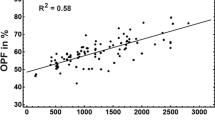Abstract
While earlier studies in the literature have established that some skeletal sodium resides in intracrystalline lattice positions and is non-exchangeable, some questions remained as to the location of that sodium which is readily exchanged. A kinetic study was made of a model system (hydroxyapatite crystals)in vitro. Only under special conditions could lattice-bound surface sites be demonstrated. Under physiological conditions, the exchange was nearly instantaneous; 99% of the final equilibrium was attained in two minutes or less. Such a rapid exchange is consistent only with an aqueous reaction. The surface sodium is, therefore, present in the hydration layers of the individual crystals. The amount of sodium associated with the crystal surface itself is, for practical purposes, insignificant.
Résumé
Bien que des études antérieures aient démontré qu'une partie du sodium squelettique est incorporée dans la maille cristalline et n'est pas échangeable, la situation du sodium mobile demande à être clarifiée. Une étude cinétique utilisant un système in vitro (cristaux d'hydroxyapatite) a été entreprise. Ce n'est que dans des conditions très particulières que des zones d'attachement superficiel à la maille cristalline ont pu être mises en évidence. Les échanges sont presque instantanés dans des conditions physiologiques: 99% de l'équilibre final est atteint en deux minutes ou moins. Un tel échange rapide ne peut s'expliquer que par une réaction aqueuse. Le sodium superficiel est, par conséquent, situé dans les couches d'hydratation des cristaux individuels. La quantité de sodium, associée à la surface cristalline, est donc pratiquement insignifiante.
Zusammenfassung
Während durch frühere Studien anhand der Literatur festgelegt werden konnte, daß ein Teil des im Skelett vorhandenen Natriums in intrakristallinen Gitterstellungen liegt und nicht austauschbar ist, blieben einige Fragen hinsichtlich der Lokalisation des rasch austauschbaren Natriums offen. Es wurde eine kinetische Untersuchung in vitro mittels eines Modellsystems (Hydroxyapatitkristalle) durchgeführt. Nur unter speziellen Bedingungen konnten die an die Gitteroberfläche gebundenen Stellungen nachgewiesen werden. Unter physiologischen Bedingungen fand der Austauch beinahe augenblicklich statt: 99% des Endequilibriums wurde in 2 min oder weniger erreicht. Ein so schneller Austausch ist nur unter Annahme einer Reaktion in wäßriger Phase denkbar. Das oberflächlich liegende Natrium ist demzufolge in der Hydratationsschicht der individuellen Kristalle vorhanden. Die an die Kristalloberfläche selbst gebundene Natriummenge ist für praktische Zwecke unwesentlich.
Similar content being viewed by others
References
Edelman, I. S., A. H. James, H. Baden, andF. D. Moore: Electrolyte composition of bone and the penetration of radiosodium and deuterium oxide into dog and human bone. J. clin. Invest.33, 121–131 (1954).
Forbes, G. B.: Bone sodium and Na22 exchange: relation to water content. Proc. Soc. exp. Biol. (N. Y.)102, 248–250 (1959).
Gabriel, S.: Chemische Untersuchungen über die Mineralstoffe der Knochen und Zähne. Hoppe-Seylers Z. physiol. Chem.18, 257–303 (1894).
Mulryan, B. J., M. W. Neuman, W. F. Neuman, andT. Y. Toribara: Equilibration between tissue calcium and injected radiocalcium in the rat. Amer. J. Physiol.207, 947–952 (1964).
Neuman, W. F., andM. W. Neuman: Chemical dynamics of bone mineral, p. 101–109. Chicago: Chicago University Press 1958.
Neuman, W. F., A. R. Terepka, F. Canas, andJ. T. Triffitt: The cycling concept of bone exchange. Calc. Tiss. Res.2, 262–270 (1968).
—,T. Y. Toribara, andB. J. Mulryan: Synthetic hydroxyapatite crystals. I. Sodium and potassium fixation. Arch. Biochem.98, 384–390 (1962).
Pak, C. Y. C., andF. C. Bartter: Ionic interaction with bone mineral. I. Evidence for an isoionic calcium exchange with hydroxyapatite. Biochim. biophys. Acta (Amst.)141, 401–409 (1967a).
——: Ionic interaction with bone mineral. II. The control of Ca++ and PO ≡4 exchange by univalent cation Ca++ substitution at the hydroxyapatite surface. Biochim. biophys. Acta (Amst.)141, 410–420 (1967b).
Stoll, W. R., andW. F. Neuman: The uptake of sodium and potassium ions by hydrated hydroxyapatite. J. Amer. chem. Soc.78, 1585–1588 (1956).
——: The surface chemistry of bone mineral. X. The lack of interaction between sodium and carbonate ions. J. Phys. Chem.62, 377–379 (1958).
Weikel, J. H., Jr., W. F. Neuman, andI. Feldman: The surface chemistry of bone. VIII. On the mechanism of ionic exchange. J. Amer. chem. Soc.76, 5202–5207 (1954).
Author information
Authors and Affiliations
Additional information
This work was supported in part by the U.S. Public Health Service Training Grant No. 1 Tl DE-175-03 and in part by the U.S. Atomic Energy Commission Contract No. W-7401-Eng-49 and has been assigned Report No. UR-49-984.
Rights and permissions
About this article
Cite this article
Neuman, W.F., Mulryan, B.J. On the nature of exchangeable sodium in bone. Calc. Tis Res. 3, 261–265 (1969). https://doi.org/10.1007/BF02058667
Accepted:
Issue Date:
DOI: https://doi.org/10.1007/BF02058667




